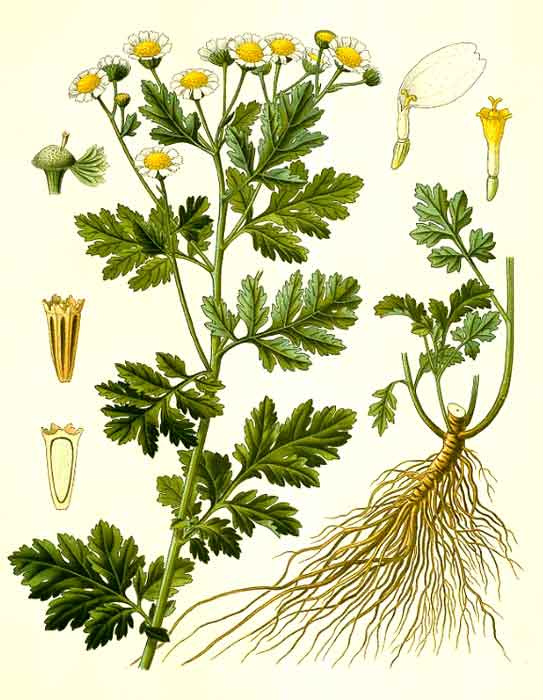Feverfew in herbal medicine

Feverfew is a natural remedy.
Feverfew (Tanacetum parthenium) is known to stop reoccurring migraine headaches, relax blood vessels, reduce swelling, stimulate digestion, expel the placenta after childbirth, promote menstruation, relieve uterine disorders, reduce fevers, and expel parasites.
Migraine headaches and feverfew
Feverfew is more of a preventive herb than a pain remedy. A suitable pain reliever such as white willow bark is required once a headache starts.
Read more about treating headache pain.
Feverfew must be used regularly to prevent the onset of migraine headaches, and effects are usually not noticed for several weeks. Feverfew can sometimes help ease common symptoms of headache, including nausea and sensitivity to light, so keep some on hand.
After taking feverfew for several weeks, many migraine sufferers report fewer and less intense headaches. Taking feverfew on a regular basis helps to inhibit the release of two inflammatory substances, serotonin and prostaglandins, both believed to contribute to the onset of migraines.
Feverfew helps control inflammation that constricts the blood vessels in the head, and prevents blood vessel spasms which may contribute to headaches. Combine with ginger for best results.

Feverfew and its uses
Feverfew leaves can be sautéed, brewed into tea, and added to stews, although it can be bitter if picked too late in the year.
Several doses of feverfew tea encourage a cleansing of the uterus after childbirth. In cases of colic, the leaves may be made into a soothing poultice and applied to the abdomen.
Taking the herb on a regular basis may prevent excessive clumping of blood platelets. Continued use of feverfew may also improve blood vessel tone.
Feverfew can be used to treat lung conditions.
Feverfew tea is good for coughs, wheezing and other lung problems. Add honey and lemon for best results.
The herb, bruised and heated, or sautéed in a little oil, is sometimes used as an external application for bloating and gas.
Feverfew may provide relief from depression, nausea, and arthritis pain.
Feverfew is sometimes used as a home remedy to help relieve allergies, arthritis, and rheumatic diseases. Long term use may provide relief from depression, nausea, and arthritis pain.
Feverfew is also used on wounds, inflammation, and as a mouthwash.

Scientific studies
Scientists have been conducting studies on feverfew since the 1970's.
- Feverfew leaves contains high levels of sesquiterpene lactones, flavonoids, and volatile oils. These substances have positive effects on smooth muscle, blood platelets, and histamine levels.
- Feverfew works to stop the occurrence of migraine headaches by inhibiting prostaglandin synthesis, decreasing smooth muscle spasm, and blocking platelet granule secretion.
- Research shows that feverfew is useful in the treatment of migraines, cluster headaches, premenstrual headaches, and other headaches.
- Feverfew also inhibits bacteria, yeast, and fungi growth.
- Feverfew shows anti-cancer activity by interrupting DNA replication and reducing oxidative stress in the cells.
- It may also be useful in the treatment of inflamed joints, rheumatoid arthritis, and psoriasis.
- One study suggests that feverfew might enhance the effectiveness of the prescription drug paclitaxel. Feverfew may also interact with blood thinners like warfarin so always talk with your doctor before taking this herb.
- Feverfew is considered a uterine stimulant, so do not take it if you are pregnant.
- Studies also show that feverfew contains terpenes that repel insects.

Feverfew is easy to grow from seeds.
Feverfew grows throughout Europe, Asia, Australia, South America, and North America. The perennial plant grows to a height of three feet and prefers full sun and average, well-drained soil.
The small yellow and white blossoms of feverfew flowers may help to purify the air and repel disease carrying insects.
Feverfew plants are also used in the garden to repel biting insects (feverfew leaves have a strong, bitter, and aromatic scent).
Of course, once blooming is underway, the bees will arrive in droves. For use in herbal remedies, gather feverfew leaves when plants first start flowering and dry or freeze them for winter use.
*Chewing fresh feverfew leaves can cause mouth sores. Feverfew can affect blood clotting rates so avoid when taking blood-thinning medications. Avoid feverfew if you are allergic to ragweed, daisies, chamomile, chrysanthemums, or yarrow.
Stop taking feverfew immediately if you experience any allergic skin reaction. Long-term feverfew users who stop treatment suddenly may experience withdrawal symptoms including headaches, anxiety, insomnia, muscle stiffness, and joint pain. Do not use feverfew if pregnant.
Seek medical attention if you have a sudden headache with high fever, double vision, confusion, numbness, or possible head injury. Always consult with a healthcare professional before using any herbal remedy especially if pregnant, nursing, or taking other medications.
Sources:
https://www.ncbi.nlm.nih.gov/pmc/articles/PMC3210009/
https://www.nccih.nih.gov/health/feverfew
Blessings to you and yours!
Thanks so much for reading my blog. Jan.

*Note - the information on this website has not been evaluated by the Food and Drug Administration.
© 2005-2024 website design and content by Janice Boling